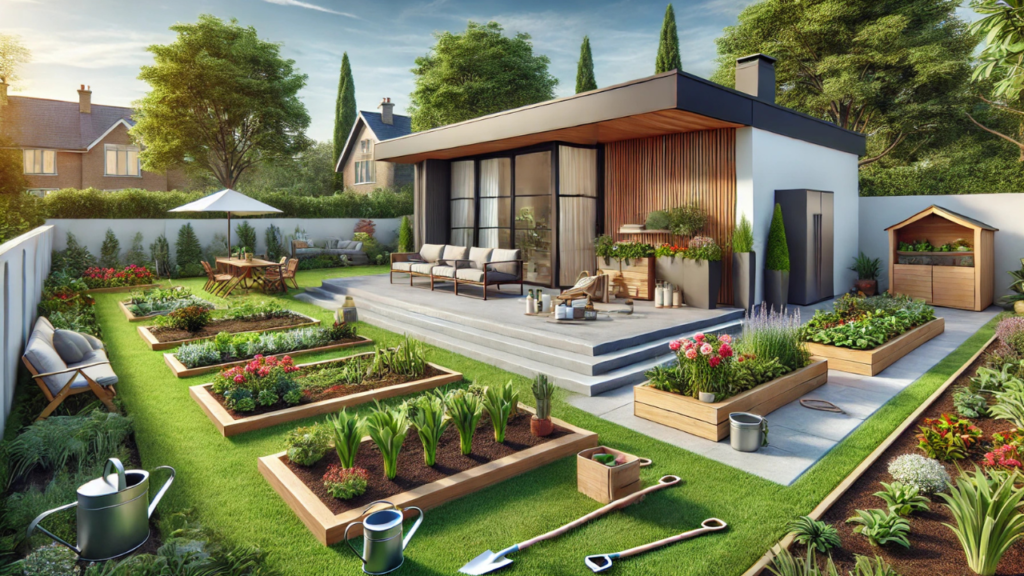The Ultimate Guide to Starting Your Outdoor Project Tips, Planning, and Execution

Starting an outdoor project is a fulfilling endeavor that allows you to create a space that suits your lifestyle and enhances the environment. Whether you are building a garden, constructing a shed, or landscaping your backyard, a well-thought-out approach is essential to achieving a successful project. In this ultimate guide, we will walk you through everything you need to know about planning, executing, and maintaining your outdoor project. From setting clear goals to choosing the right materials and tools, we’ll cover every detail so you can turn your outdoor space into something remarkable.
1. Introduction
Outdoor projects can range from simple gardening tasks to major construction jobs, and they often require careful planning to avoid costly mistakes. A successful outdoor project starts with a clear understanding of the goals you want to achieve. Whether it’s beautifying your garden, adding a functional structure, or creating an inviting entertainment space, having a concrete plan will ensure your project stays on track.
The beauty of outdoor projects lies in their versatility. You can design and execute a variety of projects based on your preferences and needs. These can include landscaping, creating a vegetable garden, adding a patio or deck, or even building a garden shed. Regardless of the scope, each project requires organization and attention to detail to ensure the final result aligns with your vision.
Planning is key, and the more time you spend thinking through each aspect of the project, the more successful your final product will be. In the following sections, we will delve deeper into the essential steps of planning, resource management, and executing an outdoor project.
2. Planning Your Outdoor Project
2.1. Setting Clear Goals
The first step to any outdoor project is defining your goals. What do you hope to accomplish? Setting clear, specific goals for your outdoor project will help you remain focused and ensure the project meets your expectations. Your goals will vary depending on the type of project. For instance, if you are building a garden, your goal may be to grow organic vegetables or create a space that attracts pollinators. If you’re constructing a patio or outdoor entertainment area, your goal may be to create a relaxing space for gatherings.
Setting long-term and short-term objectives is also important. A short-term goal could be preparing the soil for planting or completing the first stage of a construction project, while long-term goals could involve the completion of the entire project, including final landscaping and decoration. Once you establish your goals, break them down into actionable tasks so you can work systematically toward your vision.
Having a clear set of goals helps prioritize the tasks and resources you will need, and ensures your focus remains on achieving the desired results. It also gives you a sense of direction, making it easier to decide how to proceed when challenges arise.
2.2. Budgeting and Resources

Once you have set your goals, it’s time to consider the financial aspect of your outdoor project. Developing a budget is critical to ensure that you can complete the project without overspending or running into financial setbacks. Start by estimating the costs of materials, tools, and any professional help you might require. For example, if you’re building a deck, you will need to account for the costs of wood, nails, screws, and staining products, as well as the cost of hiring a contractor if you’re not completing the project yourself.
Be sure to include hidden costs such as permits or fees for waste disposal. Depending on the size and scope of the project, you may need to apply for local permits, especially when constructing buildings or adding significant landscaping. Make sure to consult local regulations to determine if any permits are required.
Additionally, consider how you will source the necessary materials and labor. You may find discounts at local suppliers, or you could consider purchasing second-hand items for specific elements of the project. Researching and comparing prices will help you stretch your budget further.
2.3. Time Management
An essential part of your planning involves establishing a realistic timeline. It is easy to get excited about starting your outdoor project, but without a solid plan in place, you could find yourself scrambling to complete the work within an unreasonable timeframe. Creating a project timeline will help you pace yourself and give you a clear idea of how long each phase of the project will take.
Start by breaking the project into smaller, manageable tasks and set deadlines for each one. For instance, if you’re building a garden, you could begin with site preparation, followed by planting, and then maintenance. Make sure to give yourself enough time for each phase, as rushing can lead to mistakes and poor results.
Set milestones to track progress and stay motivated. By visualizing the completion of each stage, you will have a sense of accomplishment that keeps you on track. Consider external factors such as weather conditions, as they can influence the timeline, especially for outdoor projects that are weather-sensitive, like planting or constructing outdoor structures.
3. Tools and Materials for Outdoor Projects
3.1. Essential Tools
Having the right tools is crucial for any outdoor project. The tools you need will depend on the type of project you’re undertaking. For smaller projects, such as planting a garden, you will need basic tools like a shovel, trowel, rake, and pruning shears. For larger projects, like building a patio or shed, you’ll need more specialized equipment, including drills, saws, hammers, and measuring tools.
Safety should be a top priority when working with tools. Invest in protective gear such as gloves, goggles, and sturdy footwear to minimize the risk of injury. It’s also important to ensure that your tools are in good working condition before beginning work. Regular maintenance and proper storage of your tools will prolong their life and ensure safety during use.
If you don’t already have the necessary tools, you can consider renting them from a local hardware store or asking friends and family for help. Alternatively, hiring professionals who own the required tools for the job can save you time and effort.
3.2. Choosing the Right Materials
The materials you choose will significantly impact the final outcome of your project. For outdoor projects, durability and weather resistance are key factors when selecting materials. For example, when building a garden bed, you may want to use pressure-treated wood that can withstand the elements, or consider alternatives like stone or metal that offer added longevity.
If you’re planning to build a patio or deck, consider materials like composite wood or natural stone, which offer excellent durability and aesthetic appeal. For landscaping, you may need soil, mulch, and various plants that are suitable for your climate.
Before making a purchase, research the materials thoroughly to understand their environmental impact, lifespan, and maintenance requirements. Opting for sustainable, eco-friendly materials can minimize harm to the environment while enhancing the longevity of your project.
3.3. Hiring Professional Help
Depending on the scale and complexity of your outdoor project, you may want to hire professional help. Some tasks, such as large-scale landscaping, structural construction, or electrical work, may be beyond the average DIYer’s capabilities. Hiring experts ensures the job is done correctly and safely.
When hiring contractors or specialists, take the time to research local professionals, read reviews, and request quotes from multiple sources to ensure you get the best service for your budget. It’s also helpful to ask for references or examples of previous work to gauge their expertise. While hiring professionals can increase the upfront cost of your project, it can ultimately save you time and money in the long run by preventing mistakes or delays.
4. Step-by-Step Execution of Your Outdoor Project
4.1. Preparing the Site
Proper site preparation is crucial for the success of your outdoor project. Begin by clearing the area of any debris, rocks, or weeds. For landscaping projects, remove any old plants or structures that may obstruct your plans. You can also level the ground to ensure a stable base for your project.
For larger construction projects, such as building a shed or patio, make sure to mark the layout clearly and take accurate measurements. This ensures everything is aligned and to scale before you begin digging or building. Preparing the site thoroughly reduces the likelihood of problems arising later in the project.
4.2. Building or Creating
The actual construction or creation phase involves putting your plans into action. This is where the bulk of the work takes place, whether you are planting your garden, assembling a structure, or installing features like paths or lighting. Work in stages, following the plan you’ve created, and make sure to measure everything as you go.
Be prepared for challenges that may arise during construction. Weather, tool malfunctions, or unanticipated site issues can sometimes delay progress. It’s essential to stay flexible and problem-solve as these challenges arise to keep the project moving forward smoothly.
4.3. Maintaining and Final Touches
Once your outdoor project is completed, it’s important to maintain it properly to ensure it lasts for years. For gardens, regular watering, weeding, and pruning will keep your plants healthy. For outdoor structures, be sure to perform periodic inspections and make any necessary repairs.
Finally, don’t forget about the finishing touches. Adding decorations, outdoor furniture, or lighting can enhance the aesthetic appeal of your space and make it more enjoyable to use. Personalize the space with elements that reflect your style and needs.
5. Conclusion
Starting an outdoor project is an exciting way to enhance your space and bring your creative ideas to life. By setting clear goals, budgeting effectively, and selecting the right materials and tools, you can ensure that your project is completed successfully. With careful planning, execution, and maintenance, your outdoor space will not only look amazing but also serve as a lasting investment for your home.
6. FAQs
6.1. What are the best materials for an outdoor patio?
Materials such as composite decking, natural stone, and stamped concrete are ideal for outdoor patios. These materials are durable, weather-resistant, and low-maintenance.
6.2. How do I start an outdoor garden project from scratch?
Start by selecting a suitable location with proper sunlight, preparing the soil, and choosing plants that are appropriate for your climate. Make sure to plan your garden layout and invest in quality tools.
6.3. How long does it take to complete a landscaping project?
Landscaping projects can vary in duration, depending on the scope. Smaller projects may take a few days to a week, while larger ones can take several weeks or even months to complete.
6.4. Do I need permits for building an outdoor structure?
Depending on the size and complexity of the structure, permits may be required. It’s important to check with local authorities to ensure you comply with building regulations.
6.5. What are some budget-friendly ideas for an outdoor DIY project?
Simple projects like creating a vegetable garden, installing a small patio with gravel, or building raised garden beds are cost-effective ways to improve your outdoor space. Consider repurposing materials to save money as well.
You May Also Read: https://businessupsid.co.uk/film-makinesi/





